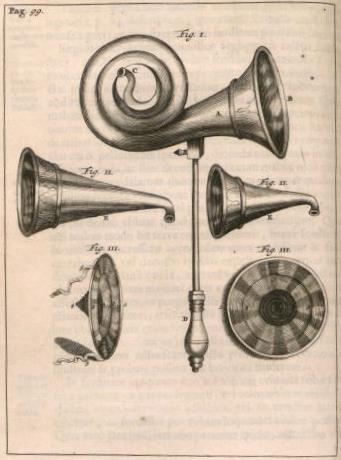
We might take it as a given that our hearing aids are hardly noticeable, can be controlled with our smart phones, and can discern between speech and background sound. What we might not realize, however, is that those capabilities are the results of 400 years of research, design, and development.
Even 5 years ago, hearing aids could not deliver the clarity of sound generated today. To see why, let’s trace the history of hearing aids—beginning today and traveling in reverse—to observe how hearing aids would have handled your hearing loss in four different years: 2016, 1985, 1940, and 1650.
2016 – Modern Digital Hearing Aids
It’s 2016 and you’re searching to treat your hearing loss. You open up an internet browser, search for a nearby hearing care provider, submit a quick form, and arrange a consultation.
At your hearing assessment, your hearing is tested using advanced computer technology that accurately measures your hearing. Then, with the assistance of your hearing care expert, you decide on a hearing aid that suits your requirements from a wide selection of models.
Then, your hearing specialist programs your new hearing aids to magnify only the sounds and frequencies you have trouble hearing, bringing about crystal clear sound without distortion.
If you were to tell someone in the 1980’s that this would be the process, they wouldn’t have thought it was possible.
So what did render it possible? In a nutshell, digital technology.
For the majority of their history, there was no way for hearing aids to discern between various sound frequencies. Hearing aids would magnify all incoming sound, including background noise, producing distorted sound.
The digital revolution addressed that problem. With digital technology, all information can be converted, stored, and manipulated as permutations of 0’s and 1’s. Digital technology enabled hearing aids to transform sound frequencies into digital information, which could then be identified in accordance with which sounds should be amplified (speech) and which should be suppressed (background noise).
The first all-digital hearing aid was produced in 1995, and since that time the technology has improved exponentially, eventually to incorporate wireless capability.
1985 – Transistor Hearing Aids
Now, imagine it’s 1985 and you’re planning to treat your hearing loss. You can forget about searching for a local hearing care provider on the web because the first commercial internet service provider won’t be founded until 1989.
You would need to use the phone book, rely on recommendations, or drive around the neighborhood to find a hearing care practice.
After booking an appointment and having your hearing evaluated, your options for hearing aids are very limited. Without the microprocessor and digital technology, hearing aids were engineered with a collection of transistors. This adds size and increased power requirements, leading to larger batteries and massive hearing aids.
Also, without the advantage of digital technology, the hearing aid cannot distinguish between different frequencies of sound. Hearing aids receive incoming sound and the transistors function as basic amplifiers, amplifying all sound. So if you’re in a loud room, speech recognition will be just about impossible.
1940 – Vacuum Tube Hearing Aids
It’s 1940 and you’re considering acquiring a hearing aid. Transistors haven’t been applied to hearing aids yet, so your options are restricted to vacuum tube hearing aids.
Vacuum tubes utilize more power than transistors, so the hearing aids call for larger batteries, making the hearing aids large, heavy, and awkward.
And once again, without digital technology, the hearing aids can only act as basic amplification systems, making all inbound sound louder. The hearing aids cannot enrich speech and can’t filter out background noise.
1650 – Ear Trumpets
Let’s travel all the way back to 1650. There’s no digital technology, no transistors, and no vacuum tubes. As a result, there is no way to transform sound into electrical currents that can be amplified.
With electrical amplification out of the question, your only choice is mechanical amplification by focusing and compressing sound into the ear canal, much like what takes place when you cup your hands around your ears.
By 1650, devices were developed that concentrated incoming sound into the ears, and these devices were labeled ear trumpets. They were prominent devices with a conical end that picked up sound and a narrow end that focused the sound into the ear.
This would be the only technology offered to individuals with hearing loss for the following 250 plus years.
Let’s return to 2016. Throughout more than 400 years of history, hearing aids have grown from mechanical amplification devices to electrical amplification devices, from vacuum-tube-based to digital-based. They’ve become significantly more compact, lighter, and more efficient and affordable.
They’ve also become much better at differentiating between different types of sound, and in amplifying only certain types of sound (like amplifying speech while repressing background noise).
Each generation of hearing aid has made a significant enhancement over the previous generation. The question is, what’s the next great milestone in the history of hearing aids?
Will we soon be able to improve natural human hearing, rather than merely restore it?
